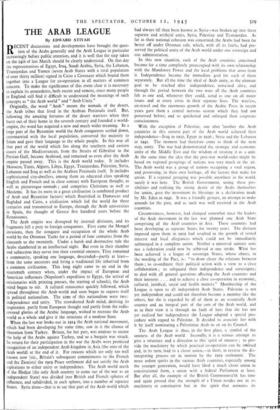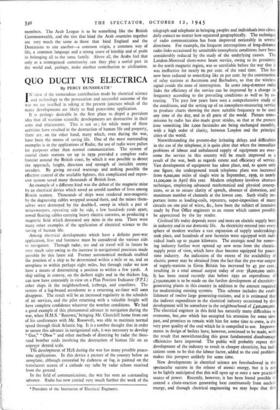THE ARAB LEAGUE
By EDWARD ATIYAH
RECENT discussions and developments have brought the ques- tion of the Arabs generally and the Arab League in particular increasingly before public attention, and it is well that the step taken on the 24th of last March should be clearly understood. On that day the representatives of Egypt, Iraq, Saudi Arabia, Syria, the Lebanon, Transjordan and Yemen (seven Arab States with a total population of over thirty million) signed in Cairo a Covenant which bound them together into a League for co-operation in all matters of common concern. To make the significance of this event clear it is necessary to explain its antecedents, both recent and remote, since many people in England still find it difficult to understand the meanings of such concepts as " the Arab world " and " Arab Unity."
Originally, the word " Arab " meant the nomads of the desert, the Arab tribes that lived in the Arabian Peninsula itself. But, following the amazing fortunes of the desert warriors when they burst out of their home in the seventh century and founded a world- empire, the word has acquired a new and much wider meaning. In a large part of the Byzantine world the Arab conquerors settled down, intermarried with the local population, converted the majority to Islam and gave their language to the whole people. In this way all that part of the world which lies along •the southern and eastern coasts of the Mediterranean, from the Straits of Gibraltar to the Persian Gulf, became Arabised, and remained so even after the Arab empire passed away. This is the Arab world today. It includes Morocco, Tunis, Algiers, Libya, Egypt, Transjordan, Palestine, Syria, Lebanon and Iraq as well as the Arabian Peninsula itself. It includes sophisticated city-dwellers, among them an educated class speaking English and French and in close contact with European thought, as well as picturesque nomads ; and comprises Christians as well as Moslems. It has its roots in a great civilisation (a combined product of Arab and Byzantine factors) which flourished in Damascus and Baghdad and Cairo, a civilisation which led the world for three centuries and transmitted to Europe, through the Arab universities in Spain, the thought of Greece five hundred years before the Renaissance.
The Arab empire was disrupted by internal divisions, and its fragments fell a prey to foreign conquerors. First came the Mongol invasions, then the conquest and occupation of the whole Arab world by the Ottoman Turks for a period of four centuries from the sixteenth to the twentieth. Under a harsh and destructive rule the Arabs slumbered in an intellectual night. But even in their slumber and subjection they never lost their essential oneness. They remained a community, speaking one language, descended—partly at least— from the same ancestors and living a traditional life inherited from a common civilisation. This long night came to an end in the nineteenth century when, under the impact of European and American influences (Napoleon's expedition to Egypt, the arrival of missionaries with printing presses, the starting of schools), the Arab mind began to stir. A cultural renascence quickly followed, which spread throughout the Arab world and soon began to express itself in political nationalism. The aims of this nationalism were two: independence and unity. The reawakened Arab mind, deriving its inspiration partly from European thought and partly from the redis- covered glories of the Arabic language, wished to recreate the Arab world as a whole and give it the structure of a modern State.
When the last war broke out in 1914 the Arab national movement,
which had been developing for some time, saw in it the chance of liberation from Turkey. Britain, for her part, was anxious to secure the help of the Arabs against Turkey, and so a bargain was struck. In return for their participation in the war the Arabs were promised recognition of an independent Arab kingdom in.Asia (the core of the Arab world) at the end of it. For reasons which are only too well known now (viz., Britain's subsequent commitments to the French and the Zionists) the 1919 Peace settlement did not satisfy the Arab aspirations to either unity or independence. The Arab world north of the Hedjaz (the only Arab country to come out of the war as an independent State) was divided into British and French spheres of
influence, and subdivided, in each sphere, into a number of separate States. Syria alone—that is to say that part of the Arab world which had always till then been known as Syria—was broken up into three separate and artificial units, Syria, Palestine and Transjordan. As far as their national cohesion was concerned, the Arabs had been far better off under Ottoman rule, which, with all its faults, had pre- served the political unity of the Arab world under one sovereign and one administration.
In this new situation, each of the Arab countries concerned became for a time completely preoccupied with its own relationship with the Mandatory Power and the local problems that arose from it. Independence became the immediate goal for each of them separately. But all the time the ideal of Arab unity, as the ultimate goal to be reached after independence, remained alive, and through the period between the two wars all the Arab countries felt as one and, whenever they could, acted as one on all major issues and at every crisis in their separate lives. The wire:ess, air-travel and the enormous growth of the Arabic Press in recent years gave them a central nervous system which they had not possessed before, and so quickened and enlarged their corporate consciousness.
With the exception of Palestine, one after 'another the Arab countries in this eastern part of the Arab world achieved their independence—Iraq in 1930, Egypt in 1936 ; Syria and the Lebanon
in 1941. The moment had therefore come to think of the next step, unity. The war had demonstrated the strategic and economic
unity of the Middle East and the wisdom of treating it as a unit.
At the same time the idea that the post-war world-order might be based on regional groupings of nations was very much in the air.
The Arab world was a group of nations occupying a vital region,
and. possessing, in their own heritage, all the factors that make for union. If a regional grouping was possible anywhere in the world,
surely it was here. The British Government, seeing these pos- sibilities and realising the strong desire of the Arabs themselves for union, gave the movement its blessings in a declaration made by Mr. Eden in 1941. It was a friendly gesture, an attempt to make amends for the past, and as such was well received in the Arab countries.
Circumstances, however, had changed somewhat since the leaders of the Arab movement in the last war planned one Arab State comprising all the Arab countries in Asia. These countries had been developing as separate States for twenty years. The division imposed upon them in 1919 had resulted in the growth of vested interest and local allegiances which could not be immediately submerged in a complete union. Neither a universal unitary state nor a federation could now be achieved at one stroke. What has been achieved is a league of sovereign States, whose object, in the wording of the Pact, is: " to draw closer the relations between them ; to co-ordinate their political action with a view to a close collaboration ; to safeguard their independence and sovereignty; to deal with all general questions affecting the Arab countries and their interests . . . and to achieve a close co-operation in economic, cultural, juridical, social and health matters." Membership of the League is open to all independent Arab States. Palestine is not yet independent and could not therefore become a member like the others, but she is regarded by all of them as an essentially Arab country and an integral part of the core of the Arab world, and as in their view it is through no fault of hers that she has not yet realised her independence the League adopted a special pro- cedure with regard to Palestine. It decided to associate her with it by itself nominating a Palestinian Arab to sit on its Council.
The Arab League is thus, in the first place, a symbol of the oneness of the Arab world. Secondly, it is a serious attempt to give a structure and a direction to this spirit of oneness ; to pro- vide the machinery by which practical co-operation can be realised and, in its turn, lead to a closer union,—in short, to reverse the dis- integrating process set in motion by the 1919 settlement. The more ardent spirits in the various Arab countries, especially among the younger generation, would have liked a much closer union in constitutional form, a union with a federal Parliament at least. But after all, the example of the British Commonwea'th has time and again proved that the strength of a Union resides not in its machinery or constitution but in the spirit that animates its members. The Arab League is to be something like the British Commonwealth, and the ties that bind the Arab countries together are very much the same as those that bind England and the Dominions to one another—a common origin, a common way of life, a common language and a strong sense of kinship and of pride in belonging all to the same family. Above all, the Arabs feel that only as a reintegrated community. can they play a useful part in the world and, perhaps, make another contribution to civilisation.



























 Previous page
Previous page